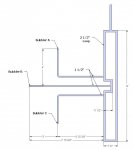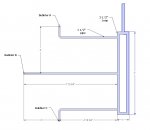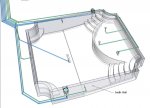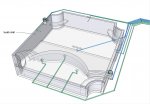You can use equivalent length to calculate head loss although it is not quite as accurate as other methods but it isn't that bad. However, the equivalent lengths for fittings that EngineeringToolBox is not the same as the Crane TP-410 manual which is the bible of hydraulics so I use the latter.
But there are a couple problems with the way you pieced together the problem:
1 - You are mixing pipe sizes and the equivalent length for the fittings is not the same between pipe sizes.
2 - You are mixing parallel with series paths and parallel paths (e.g. loop) require special handling.
3 - The flow rate is not the same in the loop as in the individual pipes so you can't calculate those together. Plus the flow rate in the loop is not a constant in all parts of the loop. Flow is split on either side of the loop but not equally and as flow is dumped to each pipe, it changes in the loop. So the loop and the pipes must be calculated separately.
The loop is not an easy calculation and requires several equations for each node with several unknowns to get the flow rate in each segment of the loop. Here is an example of a network node analysis:
http://en.wikipedia.org/wiki/Pipe_network_analysis
So I would simply ignore the loop because in reality it doesn't play a significant role and will not alter the results by very much. Ideally, you want the three pipes to be fed by a large header (again loop not required) and the feed points to be close together. The objective is to have the pressure between the three pipes to be a close as possible. Then you can make the three pipe head loss close to being the same. This will make the flow rate close to being the same.
Also, you can't ignore the exit orifice since that is were most of the head loss will occur. Jet nozzles have a more complicated head loss calculation because there tends to be a lot of transitions. Here is a rough approximation based upon some empirical formulas:
Jet Head Loss (ft) = (0.0026*(1+( 0.6*((1-(JD/PD)^2)^2))))/(JD^4) * GPM ^ 2
JD = Jet Diameter
PD = Pipe Diameter
For a 0.75" jet and a 1.61" pipe, it reduces to
Jet Head Loss (ft) = 0.011264 * GPM ^ 2
Next for the fittings, each 90 or 45 can be represented as a constant independent of pipe size, equivalent length over pipe diameter (LOD). Per Crane TP-410:
90 Ell LOD = 30
45 Ell LOD = 45
TEE Branch LOD = 60
So for a 1.5" pipe
90 Ell Leq = 30 * 1.61 / 12 = 4.025'
45 Ell Leq = 15 * 1.61 / 12 = 2.0125'
TEE Branch Ell = 60 * 1.61 / 12 = 8.05'
And for a 2.5" pipe
90 Ell Leq = 30 * 2.469 / 12 = 6.1725'
45 Ell Leq = 15 * 2.469 / 12 = 3.08625'
TEE Branch Ell = 60 * 2.469 / 12 = 12.345'
Note that you must use the actual pipe I.D. in these formulas.
But again, the 2.5" pipe loop will not be easy to calculate and not really worth the effort.
But for each of the bubbler pipes, I get the following plumbing curves:
Pipe B Head loss (ft) = 0.01212 * GPM ^2
Pipe A&D Head Loss (ft) = 0.01225 * GPM^2
Or basically a 1% difference in head loss but since head loss must be the same between the pipes, this actually means the flow rate will be about 0.6% different which is very small.
Here is a simple spreadsheet that does the calculation.
https://docs.google.com/spreadsheet/ccc ... nX0E#gid=0







